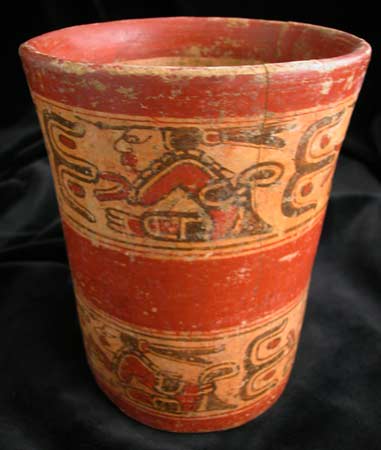Copador Style Mayan Polychrome Cylindrical Vessel, 700 CE - 900 CE
Terracotta
7.125
PF.5626
The imagery painted on this cylinder vase is characteristic of Copador pottery, a sub-style centered around the ancient Maya metropolis of Copan. Repeated along the two bands that encircle the...
The imagery painted on this cylinder vase is characteristic of Copador pottery, a sub-style centered around the ancient Maya metropolis of Copan. Repeated along the two bands that encircle the vessel is a depiction of a seated male figure, seen in profile facing left, who bends forward, reaching towards an abstract symbol resembling a backwards “E.” The figure may represent a Maya lord because of the long beaded necklace he wears seen following the contours of his arm and shoulder. However, his distinctive coiffure recalls the hairstyle of the Maize god, called Hunal Ye. The Maya aristocracy was known to impersonate this deity during religious rituals, suggesting this image may represent a member of the Maya elite disguised as Hunal Ye. The curving shape he holds, which occurs frequently in Copador pottery, is painted black and contains two red dots within its arms. Although numerous Mayanist scholars have purported their theories as to the meaning of this double-scroll motif, none of their suggestions have been widely accepted and, thus, the symbol remains a mystery. What is the meaning of this form and what is the relation between the form and the human? Clearly, it is extremely important for this entire vessel is dedicated solely to this image, repeated a total of eight times. This vessel must have played a significant role in the lives of the Mayans. Found in a tomb, buried along side a fallen ruler, this vase was as important in the afterlife as it was in this world.



